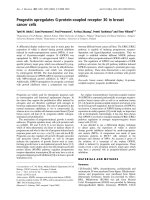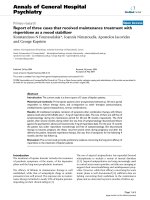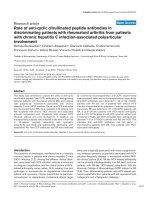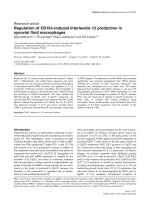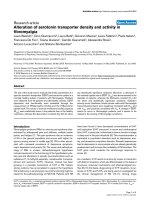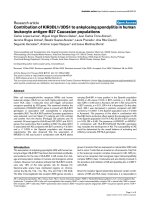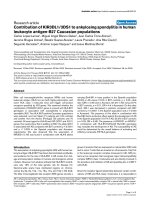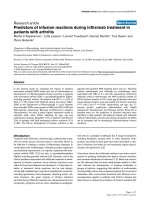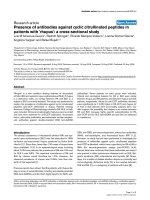Báo cáo y học: "Down-regulation of kallikrein-related peptidase 5 (KLK5) expression in breast cancer patients: a biomarker for the differential diagnosis of breast lesions" doc
Bạn đang xem bản rút gọn của tài liệu. Xem và tải ngay bản đầy đủ của tài liệu tại đây (1.26 MB, 12 trang )
CLINICAL
PROTEOMICS
Down-regulation of kallikrein-related peptidase 5
(KLK5) expression in breast cancer patients: a
biomarker for the differential diagnosis of breast
lesions
Avgeris et al.
Avgeris et al. Clinical Proteomics 2011, 8:5
(31 May 2011)
RESEARCH Open Access
Down-regulation of kallikrein-related peptidase 5
(KLK5) expression in breast cancer patients: a
biomarker for the differential diagnosis of breast
lesions
Margaritis Avgeris
1
, Georgia Papachristopoulou
1,2
, Athanasios Polychronis
2
and Andreas Scorilas
1*
* Correspondence: ascorilas@biol.
uoa.gr
1
Department of Biochemistry and
Molecular Biology, University of
Athens, Panepistimiopolis, 15701
Athens, Greece
Full list of author information is
available at the end of the article
Abstract
Background: Kallikrein-related peptidase 5 (KLK5) is a secreted trypsin-like protease
of the KLK family, encoded by the KLK5 gene. KLK5 has been found to cleave various
extracellular matrix components, as well as to activate several other KLK proteases,
triggering the stimulation of tissue microenvironment proteolytic cascades.
Material and Methods: KLK5 expression levels were quantified in 102 cancerous and
benign breast tissue specimens, obtained by randomly chosen patients, using RT-
qPCR assay. Subsequently, advanced biostatistics were applied in order to analyze
the KLK5 expression profile in the two patients’ cohorts and also to evaluate its
clinical significance for the discrimination of breast tumors.
Results: A statistically significant (p < 0.001) down-regulation of the KLK5 expression
levels were observed in the malignant specimens compared to the benign ones.
Logistic regression and ROC curve analysis revealed the significant (p < 0.001) and
the independent (p < 0.001) value of the KLK5 expression quantification, for the
discrimination of the malig nant from the benign mammary gland biopsies. Moreover,
KLK5 expression levels correlate with the pre-menopausal status (p < 0.00 5) as well as
the ER-negative staining (p = 0.028) of women with breast cancer.
Conclusions: The quantification of KLK5 expression in breast tissue biopsies may be
considered as a novel and independent biomarker for the differential diagnosis
between malignant and benig n tumors of the mammary gland.
Keywords: KLK5, Breast Cancer, Cancer Biomarkers, Tumor Markers, KLKs, Kallikreins,
Serine Proteases, Proteolysis
Introduction
The central role of protease s is widely proven in the complex and mul tiparametric
scene of cancer development and progression. Their abnormal expression and function
leads mainly to a deregulated degradation of extracellular matrix (ECM) components,
as well as to the activation of several signaling molecules and biochemical pathways.
Hence, proteases contribute at first to the creation of a malignant phenotype as well as
an impending invasiveness facilitating the spread of the tumor cells. Among the pro-
teases of the human degradome, tissue kallikrein 1 (KLK1) and the kallikrein-related
Avgeris et al. Clinical Proteomics 2011, 8:5
/>CLINICAL
PROTEOMICS
© 2011 Avgeris et al; licensee BioMed Central Ltd. This is an Op en Access article distributed under the terms of the Creative Commons
Attribution License (http: //creativecommons.org/licenses/by/2.0), which permits unrestricted use, distribution, and reproduction in
any medium, provided the original work is properly cited.
peptidases (KLK2-KLK15) compose a group of 15 conserved secreted serine proteases
with trypsin- or chymotrypsin-like activities. They are encoded by 15 structurally
homologous genes (KLK1-KLK15), which have been mapped on the 19q13.3-4 chromo-
somal region. KLKs comprise the largest family of proteases including all catalytic
classes, as they are not interrupted by any non kallikrein-related protease gene [1].
Recent studies regarding the KLKs substrate specificity have revealed their significant
association with the establishment and progression of the malignancy. These secreted
proteases ar e implicated in proteolytic cascade pathways resultin g to extended cleavage
of ECM components. The ECM degradation and remo deling, mediated directly by
KLKs or via the KLKs-induced activation of other extrac ellular proteases, interrupt
ECM physical barriers and cells’ interaction, facilitating angiogenesis and cancer cell s’
invasiveness and metastasis [2]. Moreover, during the early stages of the disease, KLKs
influence the availability of growth factors and therefore regula te tumor cells prolifera-
tion. In particular, they were found to cleave insulin-like growth factor binding pro-
teins (IGFBPs), thus releasing, in this way, the mitogenic role of insulin-like growth
factors (IGFs) [3]. Furthermore, KLKs are able to stimulate protease-activated receptors
(PARs) through the cleavage of the extracellular N-terminal segment. PARs activation
results in the triggering of an intracellular biochemical cascade leading to mitogen-acti-
vated protein kinase (MAPK) activation and cell proliferation [3,4].
Deregulated expression and secretion of KLKs has been detected in numerous malig-
nancies, especially in the endocrine-related ones. Beyond the crucial impact of KLKs
function upon the origination and progression of cancer, a plethora of studies have
already unde rlined their potential use as diagnostic and prognostic biomarkers, as well
as their contribution to the cancer patients’ monitoring [5,6]. This is clearly affirmed
by the clinical use of prostate specific antigen (PSA)/KLK3, in male population screen-
ing, early diagnosis and monitoring of prostate cancer patients.
Nowadays, breast cancer represents the most frequently diagnosed carc inoma and
the second leading cause of cancer-related deaths over female popu lations [7]. The
early detection of breast neoplasia is beneficial for the successful treatment of the
patients. However, breast tumors embrace a large number of benign lesions, requiring
different cl inical management in comparison to the malignant ones. Consequently, the
screening among KLKs for new breast cancer-specific biomarkers could further add to
the clinical diagnostic tools in the detection of mammary malignancies and the discri-
mination from non-cancerous lesions. Nevertheless, the accuracy of patients’ prognosis
will be improved and a novel panel of candidate markers will be created and evaluated.
Kallikrein-related peptidase 5 (KLK5) is a secreted trypsin-like serine protease,
encoded by the KLK5 gene of the KLKs gene family, under the transcriptional control
of estrogens and progestins [8,9]. The proteolytic activity of KLK5 has already been
proven on a big number of ECM components, such as collagens, fibronectin and lami-
nin [10]. KLKs are secreted as inactive zymogens (pro-KLKs) and their activation
depends on the proteolytic cleavage of their N-terminus pro-peptide via autocatalysis
or through other KLKs or non-KL K proteases [11]. The KLK5 aut oactivation from the
secreted pro-KLK5 represents an initial process of the KLKs proteolytic cascade, trig-
gering the activation of several other KLKs (KLK2, -3, -6, -7, -11, -12 and -14) [12].
Therefore, KLK5 has been considered to be the regulator of KLKs extracellular proteo-
lytic cascade, counterbalancing the molecular microenviroment between normal
Avgeris et al. Clinical Proteomics 2011, 8:5
/>Page 2 of 11
physiology and cancer. Therefore, KLK 5 expression quantification is critical for bo th
the discovery of the early cellular and molecular alterations in breast cancer cells, as
well as for the identification of novel diagnostic and prognostic biomarkers.
Apart from breast cancer, the prognostic value of KL K5 expression has already been
demonstrated for ovarian, bladder, prostate, colorectal and testicular cancer. In ovarian
cancer, overexpression of KLK5 protease in tumor tissues is associated with more
advanced stages and grade of the disease, as well as shorter DFS and OS of the patients
[13]. In addition, the KLK5 concentration in serum was reported to correlate with
ovaria n cancer patients’ poor response to chemotherapy [14], and poor outcome [15].
In agreemen t with the aforementioned significance of KLK5 for the ovarian canc er
patients’ prognosis, higher KLK5 gene transcription al levels were detected in patients
with aggressive forms of epithelial ovarian tumors [16], while the differential profile of
the expressed KLK5 mRNA transcript variants between normal and malignant ovarian
cancer cell s was uncovered [17]. In bladder cancer, upregulated KLK5 expression was
recently found to correlate with the invasive phenotype of the disease [18]. On the
other hand, higher levels of KLK5 expression were detected more frequently in less
aggressive forms of prostate tumors [19,20], while recent findings have demonstrated
theclinicaluseofKLK5 expression as a biomarker for the prediction of prostate
patients’ response to chemo therapy [21,22]. In addit ion, an unfavorable patients ’ out-
come has been associated wit h the KLK5 protease accumulation in colorectal cancer
tissues [23]. Finally, in testicular cancer, the down-regulation of KLK5 gene expression
in tumor tissues is associated with later stage and more invasive tumors [24].
Considering t his significant a nd central role of KLK5, we used a quantitative real-
time RT-PCR (RT-qPCR) assay for the KLK5 expression quantification in 102 malig-
nant and benign t umor breast tissues. Extensive statistics were applied in order to
investigate the KLK5 expression association with the histological features of breast can-
cer patients, aiming to examine its clinical value for the discrimination of the cancer-
ous from non-cancerous breast lesions.
Materials and methods
Breast tissue specimens and study population
A total of 69 malignant and 33 benign tumor breast tissue specimens were collected in
order to analyze the KLK5 expression profile in breast tumors. The patients, having
undergone s urgical tumor dissection between October 2005 and May 2009 , had not
received any hormonal therapy or chemotherapy tre atment prior to the surgery. Histo-
logical analysis was performed, by the same pathologist, for the discrimination of the
malignant from the benign tumor specimens,aswellasfortheevaluationofbreast
cancer patients’ TNM stage, grade, estrogen receptor (ER) and progesterone receptor
(PR) staining, axillary lymph node status and tumor size. The 69 breast cancer patients
were diagnosed with primary ductal adenocarcinoma, while among the 33 patients car-
rying benign lesions, 22 (69.7%) were suffering from fibroadenoma, 5 (15.2%) from
fibrocyst, 4 (12.1%) from fibroepitheliosis and 1 (3%) from tubular adenoma.
Our study was performed with respect to the ethical standards of the 1975 D eclara-
tion of Helsinki, as revised in Tokyo 2004. Institutional approval for the use of the
breast samples was obtained from the ethical committee of the Oncological Hospital
“G.Gennimatas” IKA-ETAM of Athens.
Avgeris et al. Clinical Proteomics 2011, 8:5
/>Page 3 of 11
Total RNA extraction and cDNA synthesis
Total RNA was isolated from 50-100 mg breast tissue samples using TRI-reagent
(Ambion Inc., Austin, TX, USA) following the manufacturer’s instructions. Total RNA
concentration and quality were determined spectrophotometrically at 260 and 280 nm,
while RNA integrity was evaluated using agarose gel electrophoresis. Reverse transcrip-
tion of the mRNA molecules into first-strand cDNA, was carried out using 1 μgof
total RNA from each tissue specimen, M-MuLV Reverse Transcriptase RNase H
-
(Finnzymes Oy, Espoo, Finland) and an Oligo (dT) oligonoucleotide as reverse tr an-
scription primer.
Quantitative Real-Time PCR
A SYBR-Green fluorescence-based quantitative Real-Time PCR assay (qPCR) was used
for the determination of KLK5 expression levels in the breast specimens on an ABI
Prism 7500 The rmal Cycler (Applied Biosystems, Foster City, CA, USA). Based on the
mRNA sequences from the NCBI Sequence database, gene specific primers were
designed and synthesized for KLK5 target gene (NCBI Reference Sequence:
NM_012427.4) and HPRT1 (hypoxanthine phosphoribosyltransferase-1) endogenous
reference gene (NCBI Reference Sequenc e: NM_000194.2) using the Primer Express
software (Applied Biosystems). A 151bp fragment was amplified using the KLK5 for-
ward 5’ -CCGGTGACAAAGCAGGT AGAG-3’ and reverse 5’ -GTGAACTTGCA-
GAGGTTCGTGTA-3’ pair of primers, whereas the use of the HPRT1 forward 5’ -
TGGAAAGGGTGTTTATTCCTCAT-3’ and reverse 5’ -ATGTAATCCAGCAGGT-
CAGCAA-3’ primers led to the accumulation of a specific 151bp product.
The final 10 μL reaction volume includes 5 μLof2×PowerSYBR
®
Green PCR
Master Mix (Applied Biosystems), 50 nM of each primer and 0.2 μLcDNA.Thether-
mal protocol consists of a 10 min polymerase activation step at 95°C, followed by 40
cycles of denaturation at 95°C for 15 sec and primer annealing and extension at 60°C
for 1 min.
Both the KLK5 target gene and the HPRT1 reference gene sequences were amplified
in separate duplicate reactions for each sample and the average C
T
value was calcu-
lated. Relative quantification analysis, using the comparative C
T
(2
-ΔΔCT
) method [25],
was completed for the determination of the KLK5 mRNA expression, where the
HPRT1 expression was used as the endogenous reference gene for the normalization of
the KLK5 expression and the BT20 breast cancer cell line as a calibrator, as previously
described
26
.
Statistical Analysis
Due to the fact that the distributions of KLK5 expression levels in breast tumors were
not Gaussian, the analysis of the differences in the two groups of patients was per-
formed with the non-parametric Mann-Whitney U test. The ability of the variables to
predict the presence of breast cancer was studied using univariate and multivariate
unconditional logistic regression analyses. Associations between KLK5 expression sta-
tus and other clinicopathological variables of the breast cancer patients were analyz ed
using the Chi-Square (c2) and Fisher’s exact tests, where appropriate.
Receiver operating characteristic ( ROC) curve was constructed for KLK5 expression
levels, by plotting sensitivity versus (1-specificity). The areas under the ROC curves
Avgeris et al. Clinical Proteomics 2011, 8:5
/>Page 4 of 11
(AUC) were analyzed by the Hanley and McNeil method.
A p-value of 0.05 (or less) was considered as statistically significant.
Results
Determination of the RT-qPCR amplification efficiencies for KLK5 and HPRT1
The relative quantification of the KLK5 mRNA expression was performed with the use
of the comparative C
T
(2
-ΔΔCT
) method, whereas the HPRT1 was employed as endo-
genous reference gene and the BT20 breast cancer cell line as the calibrator of the
assay. However, the use of 2
-ΔΔC
T
method requires the approximately equal amplifica-
tion efficiencies of the target and the reference genes. Therefore, prior to the assess-
ment of th e KLK5 expression levels, we designed a validation experiment using as
template serial dilutions of t he BT20 cDNA covering five orders of magnitude (0.01,
0.10, 1.00, 10.0 and 100 ng) in a single run. Plotting the C
T
versus the log of the
cDNA mass of the input amount we have assess ed the C
T
values’ linear increase of the
HPRT1 amplification (y = -1,53ln(x) + 25,06) and the KLK5 amplification (y = -1,42ln
(x) + 30,50) (Figure 1), and determined the HPRT1 and KLK5 amplification efficiencies,
which was 91.6% and 102.0%, respectively. The approxima tely equal amplification effi-
ciencies of the KLK5 and HPRT1 genes a llow the quantification of the KLK5 expres-
sion levels of the breast tissues with the 2
-ΔΔCT
relative quantification method.
KLK5 expression was found to be downregulated in the malignant breast tissues
The KLK5 expression analysis in the collected breast tissues revealed a statistically sig-
nificant (p < 0.001) down-regulation of the gene transcription levels in the malignant
tumor specimen s compared to the benign ones (Figure 2). The KLK5 expression of the
benign tissue specimens ranged between 0.035-1380.4×10
3
KLK5 mRNA copies/10
3
Figure 1 Relative quantification of KLK5 expression in breast specimens by SYBR Green
fluorescence-based Real-Time PCR. Separate calibration curves for KLK5 and HPRT1 expression were
constructed from serial dilutions of BT20 breast cancer cells’ total cDNA.
Avgeris et al. Clinical Proteomics 2011, 8:5
/>Page 5 of 11
HPRT1 mRNA copies (c/Kc), while the expression in the tissue specimens obtained by
the breast cancer patients varied between 0.035-19.6x10
3
c/Kc. The median (50
th
per-
centile) value of the KLK5 expression (41.5 c/Kc) in the cancer patients’ specimens was
found to be approximately 105-fold decreased, compared to that found in the non-can-
cer patients’ breast tissues (median: 4374.1 c/Kc). The reduced KLK5 transcription in
the malignant cells was also revealed by the breast cancer patients’ KLK5 expression
analysis in quartiles, compared to the same analysis of the control cohort of patients
with benign breast modifications (Table 1).
Estimation of the predictive value of KLK5 expression regarding the presence of breast
cancer
An extended statistical analysis, including logistic regression (Table 2) and ROC analy-
sis (Figure 3), was carried out in order to evaluate the clinical value of the KLK5
expression down-regulation for the prediction of breast cancer and its discrimination
Figure 2 Distribution of KLK5 mRNA expression levels of the cancerous and the non-cancerous
breast tissue specimens. Horizontal lines indicate the median (50
th
percentile) KLK5 expression. The p
value was calculated using the Mann-Whitney U test.
Table 1 Descriptive statistics of KLK5 expression in breast tissues
Quartiles
Variables Mean ± SE
a
Range 10 25 50 (median) 75 90
Cancer (N = 69)*
KLK5 (c/Kc)
b
(1.67 ± 0.48) × 10
3
0.035-19.6 × 10
3
0.035 0.013 41.5 1129.3 5937.9
Non Cancer (N = 33)
KLK5 (c/Kc)
b
(71.1 ± 44.7) × 10
3
0.035-1380.4 × 10
3
180.6 1264.3 4374.1 12320.5 74702.3
* Ductal histotype
a
Standard error
b
KLK5 mRNA copies/10
3
HPRT1 mRNA copies normalized to the calibrator (BT20 breast cancer cell line)
Avgeris et al. Clinical Proteomics 2011, 8:5
/>Page 6 of 11
from non-cancer breast lesions in tissue biopsies.Theunivariatelogisticregression
analysis clearly shows the statistically significant (p < 0.001) negative correlation
between the KLK5 expression levels and the risk of a patient to suffer for breast can-
cer. In particular, patients with low KLK5 expression levels are at a higher risk for
breast malignancy as compared to those with high KLK5 expression profiles
(Log
10
KLK5 HR: 0.47, 95% CI: 0.32 - 0.68). The differential diagnostic impact of the
KLK5 expression levels between the malignant and the benign breast tumors as well as
the use of the KLK5 expression a nalysis for the prediction of breast cancer was also
assessed by ROC analysis. A statistically significant (p < 0.001) ability of the KLK5
expression analysis to distinguish breast cancer patients from those bearing non-can-
cerous breast alterations, was illustrated by the increased AUC (AUC = 0.829; 95%CI =
0.743-0.916).
A multivariate logistic regression analysis w as adjusted to Log
10
KLK5 expression
levels, the tumor size and the age of the patients (Table 2) with the intention to exam-
ine the independence of the differential diagnosis potential of the KLK5 mRNA expres-
sion betw een the malignant and benign breast specimens. The statistically significant
(p < 0.001) negative correlation of the KLK5 mRNA levels and the risk for breast can-
cer (crude odds ratio: 0.42, 95% CI: 0.26 - 0.67) in relation to the patients’ age and
tumor size demonstrates the independent ability of KLK5 expression quantification to
Table 2 Logistic Regression Analysis for Predicting the Presence of Breast Cancer
Univariate Analysis Multivariate Analysis
Covariant Crude Odds Ratio 95% CI p-value* Crude Odds Ratio 95% CI p-value*
Log KLK5 0.47 0.32 - 0.68 < 0.001 0.42 0.26 - 0.67 < 0.001
Size 1.12 0.80 - 1.57 0.52 1.13 0.44 - 3.42 0.69
Age 1.10 1.06 - 1.15 0.001 1.12 1.06 - 1.18 0.001
CI: Confidence Intervals
*Test for trend
Figure 3 ROC analysis of the KLK5 e xpression quantification in breast cancer prediction.Thearea
under the ROC curves (AUC) was analyzed by Hanley and McNeil method.
Avgeris et al. Clinical Proteomics 2011, 8:5
/>Page 7 of 11
discriminate the malignant breast tumor cases from those with benign lesions of the
mammary gland.
Association of the KLK5 expression with the clinicopathological features of the breast
cancer patients
Following the estimation of the KLK5 expression analysis clinical value for the differen-
tial diagnosis of breast malignancies from non-cancerous lesions in breast tissue biop-
sies, we further examined the association of the KLK5 expression with the
clinicopathological variables of the breast cancer patients (Table 3). An optimal cut-off
value equal to the 70
th
percentile of the KLK5 expression levels was a dopted in order
to separate the patients in KLK5 -negative and KLK5-positive cohorts. Statistically
strong associations were observed be tween the KLK5 expression and the menopausal
status (p = 0.005), as well as the estrogen receptor (ER) staining (p = 0.028) of the
breast cancer patients.
In more details, post-menopausal breast cancer women displayed a sig nificant down-
regulated KLK5 expression profile, with 70.2% of them to be classified as KLK5-nega-
tive, compared to the pre-/peri-menopausal ones, of whom only the 40.2% of them
were cat egorized as KLK5-negative. The study of the association between the KLK5
expression and the ER status revealed a strong negative correlation in the breast cancer
Table 3 Associations between KLK5 status and the clinicopathological variables of the
breast cancer patients
No. of patients (%)
Variable Total KLK5- negative KLK5- positive p value
Menopausal status*
Pre/peri 54 22 (40.7) 32 (59.3) 0.005
b
Post 47 33 (70.2) 14 (29.8)
Grade
c
I 3 1 (33.3) 2 (66.7)
II 30 21 (70.0) 9 (30.0) 0.34
d
III 34 25 (73.5) 9 (26.5)
TNM Tumor size
<2 cm 26 17 (65.4) 9 (34.6)
2-5 cm 37 27 (73.0) 10 (27.0) 0.79
d
> 5 cm 4 3 (75.0) 1 (25.0)
ER status
Negative 16 7 (43.8) 9 (56.3) 0.028
b
Positive 51 39 (76.5) 12 (23.5)
PR status
Negative 24 15 (62.5) 9 (37.5) 0.42
b
Positive 43 31 (72.1) 12 (27.9)
a
Cutoff point: 820 c/Kc equal to 70
th
percentile
b
Fisher’s Exact Test
c
Bloom-Scarff-Richardson grading system
d
c
2
test
c
TNM system
* In the total studied population
Avgeris et al. Clinical Proteomics 2011, 8:5
/>Page 8 of 11
patients’ cohort. The 76.5% of the ER-positive patients were classified as KLK5-nega-
tive, while the percentage of ER-negative patients being also KLK5- negati ve was only
43.8%. The associations between KLK5 expression and the breast cancer patients’ his-
tological grade, tumor size and PR staining were not proven to be statistically
significant.
Discussion
Deregulated expression of several KLKs has been detected in a large number of human
malignancies, during the establishment and progression of the disease. These altera-
tions are considered to constitute a fundamental feature of carcinogenes is, facilitating
tumor cell growth and spread [2,3]. In addition, numerous data have prompted the
expression analysis of KLKs as novel tumor biomarkers for the disease detection and
the monitoring of cancer patients [5,6]. Focusing on breast neoplasia, the early differ-
ential diagnosis of the malignant from the non-cancerous cases is essential for the
detection of breast cancer at an initial stage, as well as the decision of their appropriate
treatment. The potential use of KLKs fo r this clinical need has already been proven for
the KLK4 and KLK14 [26,27]. In the present study, we have analyzed the KLK5 expres-
sion levels in malignant and benign breast tissues, with the intension to assess its clini-
cal value for the dis crimination of the cancerous from the non-cancerous breast
tumors and its association with the prevalence of the disease.
The KLK5 expression analysis highlights the gene’s high transcriptional levels in mam-
mary gland; where both the cancerous and the ben ign breast tissue specimens showed
detectable KLK5 expression. In addition, the analysis revealed a statistically significant (p <
0.001) down-regulation of the gene’s expression in the breast cancer patients’ tissues, in
relation to those obtained from patients with benign lessions. The gene transcription
reduction is strongly depicted by the approximately 105-fold drop of the median KLK5
expression levels in cancerous specimens compared to non-cancerous ones. This signifi-
cant down-regulation of KLK5 expression in malignant breast tissues has also been
reported previously [28]. Moreover, the down-regulation of the KLK5 expression was also
confirmed in breast cancer metastases compared to primary cancer cores, thus highlight-
ing the downregulation of the KLK5 expression throughout breast cancer progression.
The clinical ability of the KLK5 expression quantification to discriminate the malignant
from the benign lesions of the mammary gland was evaluated by both logistic regression
and ROC curve analyses. The univariate logistic regression model disclosed a statistically
significant (p < 0.001) elevated risk of the patients with reduced KLK5 expression to suffer
from breast cancer. In addition, the ROC analysis illustrated the statistically significant (p
< 0.001) value of the KLK5 expression quantification for the discrimination of the malig-
nant from the beni gn specimens. Moreover, the multivariate logistic regression models
supported the notion that KLK5 expression levels can independently predict the presence
of breast cancinoma. Indeed, the fact that KLK5 expression was shown to constitute a
tumor size-independent biomarker for breast cancer prediction highlights its significance
for the discrimination of malignant lesions at an early stage of the disease.
The down-reg ulation of the KLK5 expression in breast neoplasia does not confirm
previous studies, which showed elevated concentration levels of the KLK5 protein in
the serum of breast cancer patients, compared to those be aring benign tumors [29].
However, the d isruption of the breast tissue microenvir onme nt architecture occurring
Avgeris et al. Clinical Proteomics 2011, 8:5
/>Page 9 of 11
during cancer establi shment and progression leads to an extended leak of secreted
extracellular molecules into blood circulation, causing their higher serum concentra-
tions. Taking into consideration that KLK5 proteolytic function is responsible f or the
catalytic cleavage and activation of several others KLKs, the down-regulation of the
KLK5 expression in breast cancer tissues possibly signifies the result of a negative reg-
ulatory mechanism. With this mechanism, the cells strive maybe to counterbalance the
abnormal activation of the KLK proteolytic cascade contributing to their homeostasis.
Apart from the evaluation of KLK5 expression for the differential diagnosis of breast
cancer, we further exam ined the KLK5 expression status association with breast cancer
patients’ clinocopathological features, in order to assess its prognostic significance for
the patients. Statistically significant association of t he KLK5 mRNA levels with the ER-
negative staining (p = 0.028) and the pre-/peri-menopausal status (p = 0.005) was
observed in breast cancer patients. The association between the KLK5 expression and
the breast cancer patients’ grade, tumor size and PR staining was not found to be statis-
tically solid (p > 0.05). These results are in agreement with previous studies examining
of the KLK5 expression prognostic value in breast cancer patie nts, whereas the KLK5
expression quantification proved to be an independent biomarker for the prediction of
breast cancer patients’ DFS and OS [30]. The association of the KLK5 expression levels
with the pre-menopausal status of breast cancer patients was expected, due to the drop
of circulating estrogens of the post-menopausal women. However, the correlation of the
KLK5 expression with the ER-negative status of the cancer patients is in contrast with
the up-regulation of KLK5 expression by estrogens. A possible explanation for this dis-
similarity is the ER-independent regulated impact of estrogens on KLK5 transcription.
Conclusion
The aim of the current study was the expression analysis of KLK5 in cancerous and
benign breast lesions, targeting the evaluation of the clinical use of KLK5 expression
for the discrimination of the malignant from the non-cancerous tumors of the mam-
mary gland. Significantly decreased KLK5 transcription was detected in tissues of
breast cancer patients compared to those bearing benign tumors. This down-regulation
of KLK5 expression may be considered as an indepe ndent novel biomarker for the dif-
ferential diagnosis between the malignant and benign breast tumors. A large scale
KLK5 expression analysis in breast tissue specimens, as well the study of the KLK5
alternatively spliced variants must be carried out, in order to reinforce the significance
of KLK5 expression analysis in breast cancer patients and to reveal the molecular
alterations that occur during breast carcinogenesis.
Author details
1
Department of Biochemistry and Molecular Biology, University of Athens, Panepistimiopolis, 15701 Athens, Greece.
2
Oncological Hospital “G.Gennimatas” IKA-ETAM of Athens, Asopiou 4, 11473 Athens, Greece.
Authors’ contributions
MA participated in the conception and design of the study, the acquisition, the analysis and the interpretation of the
data, the statistical analysis and drafted the manuscript.
GP participated in the conception and design of the study and the acquisition, the analysis and the interpretation of
the data.
AP participated in the conception and design of the study and the acquisition of the data.
AS participated in the conception and design of the study, the analysis and the interpretation of the data, the
statistical analysis and supervised the study.
All authors read and approved the final manuscript.
Avgeris et al. Clinical Proteomics 2011, 8:5
/>Page 10 of 11
Competing interests
The authors declare that they have no competing interests.
Received: 7 April 2011 Accepted: 31 May 2011 Published: 31 May 2011
References
1. Yousef GM, Chang A, Scorilas A, Diamandis EP: Genomic organization of the human kallikrein gene family on
chromosome 19q13.3-q13.4. Biochem Biophys Res Commun 2000, 276:125-33.
2. Borgono CA, Diamandis EP: The emerging roles of human tissue kallikreins in cancer. Nat Rev Cancer 2004, 4:876-90.
3. Sotiropoulou G, Pampalakis G, Diamandis EP: Functional roles of human kallikrein-related peptidases. J Biol Chem
2009, 284:32989-94.
4. Oikonomopoulou K, Diamandis EP, Hollenberg MD: Kallikrein-related peptidases: proteolysis and signaling in cancer,
the new frontier. Biol Chem 2010, 391:299-310.
5. Avgeris M, Mavridis K, Scorilas A: Kallikrein-related peptidase genes as promising biomarkers for prognosis and
monitoring of human malignancies. Biol Chem 2010, 391:505-11.
6. Mavridis K, Scorilas A: Prognostic value and biological role of the kallikrein-related peptidases in human
malignancies. Future Oncol 2010, 6:269-85.
7. Jemal A, Siegel R, Xu J, Ward E: Cancer statistics, 2010. CA Cancer J Clin 2010, 60:277-300.
8. Yousef GM, Diamandis EP: The new kallikrein-like gene, KLK-L2. Molecular characterization, mapping, tissue
expression, and hormonal regulation. J Biol Chem 1999, 274:37511-6.
9. Brattsand M, Egelrud T: Purification, molecular cloning, and expression of a human stratum corneum trypsin-like
serine protease with possible function in desquamation. J Biol Chem 1999, 274:30033-40.
10. Michael IP, Sotiropoulou G, Pampalakis G, et al: Biochemical and enzymatic characterization of human kallikrein 5
(hK5), a novel serine protease potentially involved in cancer progression. J Biol Chem 2005, 280:14628-35.
11. Borgono CA, Michael IP, Diamandis EP: Human tissue kallikreins: physiologic roles and applications in cancer. Mol
Cancer Res 2004, 2:257-80.
12. Michael IP, Pampalakis G, Mikolajczyk SD, Malm J, Sotiropoulou G, Diamandis EP: Human tissue kallikrein 5 is a
member of a proteolytic cascade pathway involved in seminal clot liquefaction and potentially in prostate cancer
progression. J Biol Chem 2006, 281:12743-50.
13. Diamandis EP, Borgono CA, Scorilas A, et al: Immunofluorometric quantification of human kallikrein 5 expression in
ovarian cancer cytosols and its association with unfavorable patient prognosis. Tumour Biol 2003, 24:299-309.
14. Oikonomopoulou K, Li L, Zheng Y, et al: Prediction of ovarian cancer prognosis and response to chemotherapy by a
serum-based multiparametric biomarker panel. Br J Cancer 2008, 99
:1103-13.
15. Dorn J, Magdolen V, Gkazepis A, et al: Circulating biomarker tissue kallikrein-related peptidase KLK5 impacts ovarian
cancer patients’ survival. Ann Oncol 2011.
16. Kim H, Scorilas A, Katsaros D, et al: Human kallikrein gene 5 (KLK5) expression is an indicator of poor prognosis in
ovarian cancer. Br J Cancer 2001, 84:643-50.
17. Dong Y, Kaushal A, Brattsand M, Nicklin J, Clements JA: Differential splicing of KLK5 and KLK7 in epithelial ovarian
cancer produces novel variants with potential as cancer biomarkers. Clin Cancer Res 2003, 9:1710-20.
18. Shinoda Y, Kozaki K, Imoto I, et al: Association of KLK5 overexpression with invasiveness of urinary bladder
carcinoma cells. Cancer Sci 2007, 98:1078-86.
19. Korbakis D, Gregorakis AK, Scorilas A: Quantitative analysis of human kallikrein 5 (KLK5) expression in prostate
needle biopsies: an independent cancer biomarker. Clin Chem 2009, 55:904-13.
20. Yousef GM, Scorilas A, Chang A, et al: Down-regulation of the human kallikrein gene 5 (KLK5) in prostate cancer
tissues. Prostate 2002, 51:126-32.
21. Thomadaki H, Mavridis K, Talieri M, Scorilas A: Treatment of PC3 prostate cancer cells with mitoxantrone, etoposide,
doxorubicin and carboplatin induces distinct alterations in the expression of kallikreins 5 and 11. Thromb Haemost
2009, 101:373-80.
22. Mavridis K, Talieri M, Scorilas A: KLK5 gene expression is severely upregulated in androgen-independent prostate
cancer cells after treatment with the chemotherapeutic agents docetaxel and mitoxantrone. Biol Chem 2010,
391:467-74.
23. Talieri M, Li L, Zheng Y, et al: The use of kallikrein-related peptidases as adjuvant prognostic markers in colorectal
cancer. Br J Cancer 2009, 100:1659-65.
24. Yousef GM, Obiezu CV, Jung K, Stephan C, Scorilas A, Diamandis EP: Differential expression of Kallikrein gene 5 in
cancerous and normal testicular tissues. Urology 2002, 60:714-8.
25. Livak KJ, Schmittgen TD: Analysis of relative gene expression data using real-time quantitative PCR and the 2(-Delta
Delta C(T)) Method. Methods 2001, 25:402-8.
26. Papachristopoulou G, Avgeris M, Charlaftis A, Scorilas A: Quantitative expression analysis and study of the novel
human kallikrein-related peptidase 14 gene (KLK14) in malignant and benign breast tissues. Thromb Haemost 2011,
105:131-7.
27. Papachristopoulou G, Avgeris M, Scorilas A: Expression analysis and study of KLK4 in benign and malignant breast
tumours. Thromb Haemost 2009, 101
:381-7.
28. Li X, Liu J, Wang Y, Zhang L, Ning L, Feng Y: Parallel underexpression of kallikrein 5 and kallikrein 7 mRNA in breast
malignancies. Cancer Sci 2009, 100:601-7.
29. Yousef GM, Polymeris ME, Grass L, et al: Human kallikrein 5: a potential novel serum biomarker for breast and
ovarian cancer. Cancer Res 2003, 63:3958-65.
30. Yousef GM, Scorilas A, Kyriakopoulou LG, et al: Human kallikrein gene 5 (KLK5) expression by quantitative PCR: an
independent indicator of poor prognosis in breast cancer. Clin Chem 2002, 48:1241-50.
doi:10.1186/1559-0275-8-5
Cite this article as: Avgeris et al.: Down-regulation of kallikrein-related peptidase 5 (KLK5) expression in breast
cancer patients: a biomarker for the differential diagnosis of breast lesions. Clinical Proteomics 2011 8:5.
Avgeris et al. Clinical Proteomics 2011, 8:5
/>Page 11 of 11
